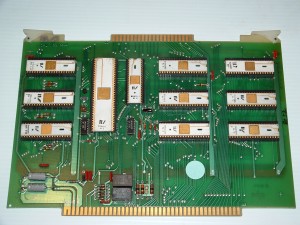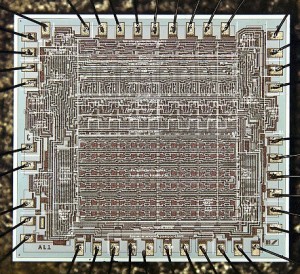Four-Phase Systems AL1 Processor – 8-bits by Lee Boysel
In today’s tech economy there are companies that serve as incubators for startups, such institutions as Y-Combinator and Techstars entire purpose is to help develop emergent tech companies. In the 1960’s there was also tech incubators, perhaps the best known is Fairchild. The difference is that Fairchild was not designed to be an incubator, nor were they trying to be. The bureaucracy of such a large corporation allowed many engineers in somewhat marginal positions to work extensiely on projects of their own. Projects that perhaps were not directly beneficial to Fairchild, but close enough related to slip under managements noses. Many of the ‘great’ semiconductor companies were started by former Fairchild employees, Robert Noyce, co-founder of Intel, being perhaps the most famous.
Lee Boysel started work at Fairchild in 1966 after working at several other companies semiconductor departments. Boysel had one main focus, MOS. MOS (Metal-Oxide-Semiconductors) were very new in the 1960’s and their potential was not well understood. Most IC’s were designed using Bipolar technology but Boysel saw the potential of MOS and worked at Fairchild to perfect its processes. He designed a 256-bit RAM in MOS< as well as an 8-bit full adder, as well as the first MOS IC with over 100 gates. None of these designs were of great commercial success, but that was Fairchild’s problem, not Boysel’s. Boysel was building the foundations for his greater plans, plans that would be realized only after leaving Fairchild.
Boysel left Fairchild in 1968, to build a new company known as Four-Phase Systems. Four-Phase was named after the 4-phase clocking system used in the MOS logic Boysel had designed. Boysel’s goal was to build a single chip computer using MOS and use it to power systems to rival the likes of Data General and IBM. Initial funding of $2 million was provided, somewhat ironically, by Corning Glass works, who also owned a large portion of Signetics. Initial production of Boysel’s designs was by yet another Fairchild incubated startup known as Cartesian inc. Cartesian was offered foundry services that duplicated Fairchild;s MOS process. This saved Four-Phase from having to build there designs for a completely new process.
By 1970 Four-Phase Systems had working engineering systems. The base of this system was a chip called the AL1. The AL1 was an 8-bit processor with 8 registers (including the PC) and a full 8-bit ALU. Four-Phase used three of them in a system to form a 24-bit computer. Additional chips were also used, 3 x ROM chips, 3 x Random logic and associated clock generation for the 4-phase clock. The 4-Phase clocking is also notable, it allowed the use of minimum size transistors for most gates. This increases the chip density and performance greatly. The AL1 had over 1000 gates (~4000 transistors) with a die size of 130×120 mils (100mm2). This was essentially the complexity of Intels 8008 but with a die size of Intel’s 4-bit 4004. Furthermore, the speed was around 1 MHz, nearly 10-times anything else at the time, even on the same 10 micron process. Also contributing to the speed of the AL1 was its package, not somthing often thought of today, but packaging mattered. Intel’s 8008 was packed in an 18 pin DIP package as this package was cheap. This required I/O to be multiplexed, which causes a speed penalty. The AL1 used a , at the time, expensive 40 pin package. This package cost around $5, which doesn’t seem like much, but when a smaller package could be had for under $1, it added up. The benefit was the AL1 has all the I/O it needed with no multiplexing.
So why isn’t the AL1 more well known? Outside of a court case in 1990 where TI used it to try to invalidate an Intel patent, the AL1, and Four-Phase are relatively unknown in the IC realm. The reason is the Four Phase IV/70. The IV/70 was what the AL1 powered, a distributed computer system that was Four-Phase first commercial computer product, and the entire reason for the AL1’s creation. Boysel was not interested in selling chips, he wanted to sell systems, and sell then he did, by 1973 Four-Phase had an installed base of 350 systems and over 4000 terminals at major corporations all over the globe. The IV/70 (and later the IV/90) were half the cost of comparable IBM systems. In 1971 Four-Phase signed an agreement with another foundry called Advanced LSI Services to produce the AL1 and other chips.
Four-Phase never advertised its chips or even the processor boards, they considered them a means to an end, to sell (or rather lease) very large distributed systems. It is for this reason that the AL1 is virtually unknown, and for this reason that the Intel 4004 is cited as the first integrated processor, as thats what Intel said it was, and nobody at the time really bothered to challenge them on it, there were much more important things to do, silicon to build and test, and clock speeds to increase.
Four Phase continued to be successful in the computer industry, eventually selling to Motorola in 1981 for a $253 million stock deal. Today we find remnants of this great company in the form of chips. Data is of course scarce, as the AL1 was an internal design, not supported outside of a company that no longer exists.
Four-Phase did at least mark their chips in a fairly consistent fashion, greatly helping with the ID
Part numbers generally are 8 digits and contain the device type, mask major rev and a minor revision
91100xxx – 1kbit DRAM – a base IV/70 used 48 of them
911200xx – Random Logic chip (RL1-RL5) These are the glue logic used to tie the system together
91130121 – I/O 12 I/O Controller
91140011 – Original AL1
91140021 – AL2
91140031 – AL3 Both the AL2 and AL3 were used on the IV/70 processor board with 3x AL4s as well)
91140041 – AL4 -Remask of the AL1
91150052 – MC-5 Unknown but likely a Memory Controller
913100xx – A variety of 256 bit ROM chips
A pic of many of these can be seen here





May 2nd, 2019 at 1:26 pm
I worked for Four Phase in the 80s. I still have a few of the chips laying around. The IV/70 was a great key to disk system thanks to the B3 bus. It had 24 switches in the front of it that you could walk bits through the registers to troubleshoot. Even into the 2000s the IRS still was using Four Phase system to process your tax returns. They had many companies come in trying to replace the old Four Phase boxes but they couldn’t match the performance of the 20 year old systems. Last refuse to the Four Phase system was in the Bahamas, where many old used Phase Systems went to data entry shops for American Airlines and other companies. Lee Boysel sold at the right time and made a killing as we were just starting to see the decline in the front end market for the mainframes. Motorola had no idea what to do with Four Phase other than trying to sell their 68000 based Unix boxes. They sold at a fraction of the old Four Phase system did and couldn’t keep the business afloat.
May 13th, 2020 at 8:53 am
Wrote code for data entry on a Data IV 90 for the Department of Defense in the 1970’s. First Defense Contract entre into the key – to – shared processing arena; huge cultural change but well received since system was so dependable and easy to use. Effectively served as the front-end processor for a Honeywell 2070 Mainframe.
July 18th, 2020 at 8:23 pm
457 on the front panel toggle key was a shift parallel right instruction on the console
September 27th, 2020 at 10:22 pm
Hello, I am searching and searching for anyone with docs, manuals or info on Four Phase Systems Series 2000 model 290 Computers
Drop me a line if you can bill@corcoran.life
January 31st, 2024 at 9:21 pm
There is as well a 91130072 chip. 3thereofare used to control the 24 data/address switches of the front panel as seen here https://retrocomputing.stackexchange.com/questions/28353/origin-of-what-seems-to-be-a-front-panel